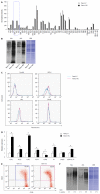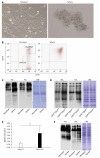Fucosylation is a common glycosylation type in pancreatic cancer stem cell-like phenotypes
- PMID: 25852272
- PMCID: PMC4385534
- DOI: 10.3748/wjg.v21.i13.3876
Fucosylation is a common glycosylation type in pancreatic cancer stem cell-like phenotypes
Abstract
Aim: To evaluate/isolate cancer stem cells (CSCs) from tissue or cell lines according to various definitions and cell surface markers.
Methods: Lectin microarray analysis was conducted on CSC-like fractions of the human pancreatic cancer cell line Panc1 by establishing anti-cancer drug-resistant cells. Changes in glycan structure of CSC-like cells were also investigated in sphere-forming cells as well as in CSC fractions obtained from overexpression of CD24 and CD44.
Results: Several types of fucosylation were increased under these conditions, and the expression of fucosylation regulatory genes such as fucosyltransferases, GDP-fucose synthetic enzymes, and GDP-fucose transporters were dramatically enhanced in CSC-like cells. These changes were significant in gemcitabine-resistant cells and sphere cells of a human pancreatic cancer cell line, Panc1. However, downregulation of cellular fucosylation by knockdown of the GDP-fucose transporter did not alter gemcitabine resistance, indicating that increased cellular fucosylation is a result of CSC-like transformation.
Conclusion: Fucosylation might be a biomarker of CSC-like cells in pancreatic cancer.
Keywords: Anti-cancer drug resistance; Cancer stem cells; Fucosylation; Glycosylation; Pancreatic cancer; Sphere formation.
Figures







Similar articles
-
CD44-positive cells are responsible for gemcitabine resistance in pancreatic cancer cells.Int J Cancer. 2009 Nov 15;125(10):2323-31. doi: 10.1002/ijc.24573. Int J Cancer. 2009. PMID: 19598259
-
Chemosensitization and inhibition of pancreatic cancer stem cell proliferation by overexpression of microRNA-205.Cancer Lett. 2017 Aug 28;402:1-8. doi: 10.1016/j.canlet.2017.05.007. Epub 2017 May 20. Cancer Lett. 2017. PMID: 28536008 Free PMC article.
-
The miR-17-92 cluster counteracts quiescence and chemoresistance in a distinct subpopulation of pancreatic cancer stem cells.Gut. 2015 Dec;64(12):1936-48. doi: 10.1136/gutjnl-2014-308470. Epub 2015 Apr 17. Gut. 2015. PMID: 25887381 Free PMC article.
-
Fucosylation in Urological Cancers.Int J Mol Sci. 2021 Dec 11;22(24):13333. doi: 10.3390/ijms222413333. Int J Mol Sci. 2021. PMID: 34948129 Free PMC article. Review.
-
Significance of CD44 and CD24 as cancer stem cell markers: an enduring ambiguity.Clin Dev Immunol. 2012;2012:708036. doi: 10.1155/2012/708036. Epub 2012 May 30. Clin Dev Immunol. 2012. PMID: 22693526 Free PMC article. Review.
Cited by
-
Impact of Fucosylation on Self-Assembly of Prostate and Breast Tumor Spheroids by Using Cyclo-RGDfK(TPP) Peptide and Image Object Detection.Onco Targets Ther. 2019 Dec 17;12:11153-11173. doi: 10.2147/OTT.S235811. eCollection 2019. Onco Targets Ther. 2019. PMID: 31908483 Free PMC article.
-
Integrated glycomic analysis of ovarian cancer side population cells.Clin Proteomics. 2016 Nov 10;13:32. doi: 10.1186/s12014-016-9131-z. eCollection 2016. Clin Proteomics. 2016. PMID: 27833472 Free PMC article.
-
Alpha-1-antichymotrypsin as a novel biomarker for diagnosis, prognosis, and therapy prediction in human diseases.Cancer Cell Int. 2022 Apr 19;22(1):156. doi: 10.1186/s12935-022-02572-4. Cancer Cell Int. 2022. PMID: 35439996 Free PMC article. Review.
-
Profiling of different pancreatic cancer cells used as models for metastatic behaviour shows large variation in their N-glycosylation.Sci Rep. 2017 Nov 30;7(1):16623. doi: 10.1038/s41598-017-16811-6. Sci Rep. 2017. PMID: 29192278 Free PMC article.
-
Treatment of ovarian cancer by targeting the tumor stem cell-associated carbohydrate antigen, Sialyl-Thomsen-nouveau.Oncotarget. 2018 May 1;9(33):23289-23305. doi: 10.18632/oncotarget.25289. eCollection 2018 May 1. Oncotarget. 2018. PMID: 29796189 Free PMC article.
References
-
- Reya T, Morrison SJ, Clarke MF, Weissman IL. Stem cells, cancer, and cancer stem cells. Nature. 2001;414:105–111. - PubMed
-
- Ailles LE, Weissman IL. Cancer stem cells in solid tumors. Curr Opin Biotechnol. 2007;18:460–466. - PubMed
-
- Dean M, Fojo T, Bates S. Tumour stem cells and drug resistance. Nat Rev Cancer. 2005;5:275–284. - PubMed
-
- Jemal A, Siegel R, Ward E, Murray T, Xu J, Smigal C, Thun MJ. Cancer statistics, 2006. CA Cancer J Clin. 2006;56:106–130. - PubMed
Publication types
MeSH terms
Substances
LinkOut - more resources
Full Text Sources
Other Literature Sources
Medical
Research Materials
Miscellaneous

